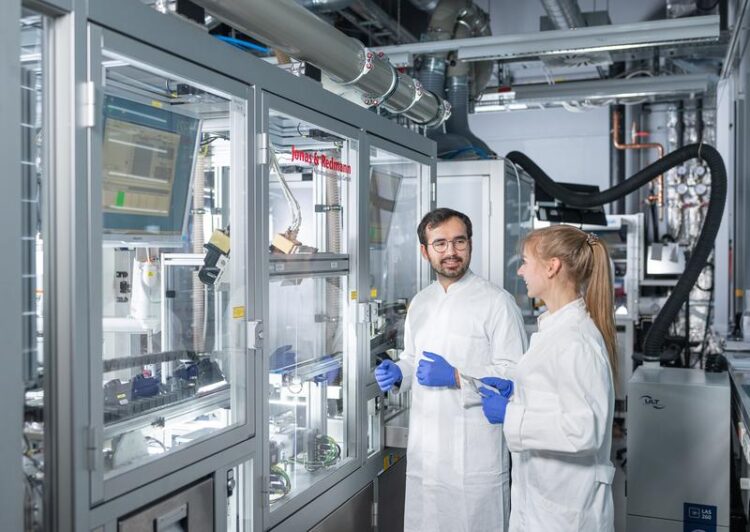Silicon Nitride-based Particles as Promising Anode Material for Solid State Batteries

Fraunhofer IWS researchers are developing the components and cells to evaluate the new material system for solid-state batteries.
© ronaldbonss.com/Fraunhofer IWS
BMBF Funds “FB2-SiSuFest” to Evaluate Novel Storage Material.
Novel storage material for solid-state batteries is the focus of the project “FB2-SiSuFest – Evaluation of silicon anodes in sulfide solid-state batteries”. As a promising anode material, silicon nitride-based particles could enable a high storage capacity with stable and safe operation. The research alliance of renowned partners has received funding from the Federal Ministry of Education and Research (BMBF) amounting to 1.7 million euros as part of the “Clusters Go Industry” funding guideline as part of the FestBatt cluster. The project will run from December 2023 to November 2025.
The ongoing development in the field of solid-state batteries faces the challenge of successfully transferring high-energy lithium metal anodes into industrial applications. The “FB2-SiSuFest” project investigates anode materials based on silicon nitride (SiNx) as a promising alternative to conventional solutions. This material could contribute to developing high-performance, safe, and stable battery cells. The research activities focus on producing and evaluating silicon nitride-based particles as anode material in sulfide solid-state batteries. The project aims to improve cycle stability significantly compared to conventional anode materials. By using amorphous nanoparticles of silicon nitride, the project partners aim to overcome the electrochemical and morphological challenges of applying pure silicon.
Silicon Nitride: Possible Alternative to Lithium Metal Anode?
Research within the FestBatt cluster focuses, for example, on different variants of sulphide-based solid-state batteries as pioneering technologies. Despite progress, some questions still need to be answered regarding the successful application of the high-energy lithium metal anode. Silicon could offer itself as an alloy-forming active material. However, there are still challenges due to electrochemical and morphological instabilities. These could be overcome by using silicon nitrides as amorphous nanoparticles by creating advantageous phases during the charging and discharging process. The research network’s main objective is to further develop innovative SiNx active materials and evaluate them in composite anodes and sulfide solid-state batteries. The project team bases its work on systematic investigations, in-depth analysis, and material and process optimization, in particular, to evaluate charging and cycle stability compared to conventional silicon particles.
The experience and networking of the partner institutions, including the Institute for Inorganic and Analytical Chemistry at the University of Münster, the Fraunhofer Institute for Material and Beam Technology IWS in Dresden, the Institute for Energy and Material Processes at the University of Duisburg-Essen and the Institute of Physical Chemistry at Justus Liebig University Giessen form the solid foundation for the project. The collaboration strengthens not only the scientific exchange but also the integration with the thiophosphate and production platforms in the FestBatt Cluster.
Wissenschaftliche Ansprechpartner:
Division Manager Chemical Surface and Battery Technology
Dr. rer. nat. Holger Althues
Phone: +49 351 83391-3476
E-Mail: holger.althues@iws.fraunhofer.de
Fraunhofer Institute for Material and Beam Technology IWS
Winterbergstr. 28
01277 Dresden
Originalpublikation:
https://www.iws.fraunhofer.de/en/newsandmedia/press_releases/2024/press-release_…
Media Contact
All latest news from the category: Power and Electrical Engineering
This topic covers issues related to energy generation, conversion, transportation and consumption and how the industry is addressing the challenge of energy efficiency in general.
innovations-report provides in-depth and informative reports and articles on subjects ranging from wind energy, fuel cell technology, solar energy, geothermal energy, petroleum, gas, nuclear engineering, alternative energy and energy efficiency to fusion, hydrogen and superconductor technologies.
Newest articles

NASA: Mystery of life’s handedness deepens
The mystery of why life uses molecules with specific orientations has deepened with a NASA-funded discovery that RNA — a key molecule thought to have potentially held the instructions for…

What are the effects of historic lithium mining on water quality?
Study reveals low levels of common contaminants but high levels of other elements in waters associated with an abandoned lithium mine. Lithium ore and mining waste from a historic lithium…

Quantum-inspired design boosts efficiency of heat-to-electricity conversion
Rice engineers take unconventional route to improving thermophotovoltaic systems. Researchers at Rice University have found a new way to improve a key element of thermophotovoltaic (TPV) systems, which convert heat…



